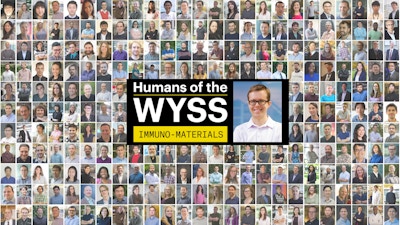
The Humans of the Wyss series features members of the Wyss community discussing how they think about their work, the influences that help shape them as scientists, and their collaborations at the Wyss Institute and beyond.
In this installment of our Immuno-Materials Edition, we talk to Kyle Vining, a graduate student in David Mooney’s lab at the Harvard John A. Paulson School of Engineering and Applied Sciences. He talks about his work studying how mechanics can regulate immune responses and how he envisions his research impacting the world.
Kyle received his undergraduate degree in Biomedical Engineering and went on to train as a dentist. During dental school, he conducted research on salivary stem cells at the National Institutes of Health (NIH) before entering a Ph.D. program at Harvard John A. Paulson School of Engineering and Applied Sciences and the Wyss Institute. In addition to research, he continues to practice general dentistry.
What drives you?
I’m curious about how the physical properties of tissues regulate immunity and immune responses. A lot of biology is focused on looking at signaling pathways and gene regulation inside the cell. It’s also important to consider the physical environment of a cell. This is broadly applicable to understanding the way the immune response is affected in injury, infection, autoimmunity, and cancer.
The goal is to one day connect the findings from our in vitro system to actual human biology to improve treatments for diseases like cancer, auto-immunity, and chronic inflammation.
You’re working on studying how mechanics can regulate immune responses within physical tissues, tell us more.
My research involves modeling the physical and mechanical properties of tissue micro-environments and examining how immunity is affected by these properties. We aim to engineer a synthetic extracellular matrix niche that allows us to tune its mechanical properties to mimic the tissue such as tumors. We use a hydrogel system to control physical parameters, such as matrix proteins, elasticity, and viscosity, to examine how they affect immune responses.
Share with us some of the challenges you’re facing.
Being a researcher can sometimes be a struggle because months can go by when it’s difficult to make significant progress. I try to balance my life with other things outside of the lab, like spending time with my wife and our Yorkie Bichon. I also like to cook – it’s artistic for me. I like to put things together and see what happens. In some sense, it’s similar to science in that oftentimes you don’t know what’s going to work.
So, how do you envison your work impacting the world?
Cancer scientists, physicians, and pharmaceutical companies are still trying to figure out why immunotherapy drugs only work in a fraction of patients and why not all types of tumors respond. We think that looking at physical environment may be helpful to solve this problem. The goal is to one day connect the findings from our in vitro system to actual human biology to improve treatments for diseases like cancer, auto-immunity, and chronic inflammation. For example, if we learn about how real tumors regulate their environment, we hope it one day might improve or yield new therapies for cancer.
